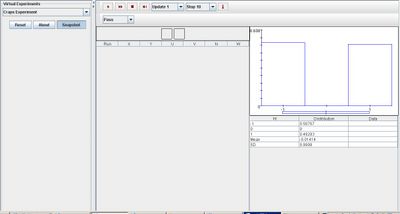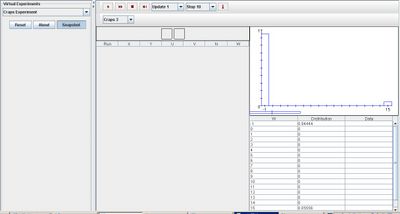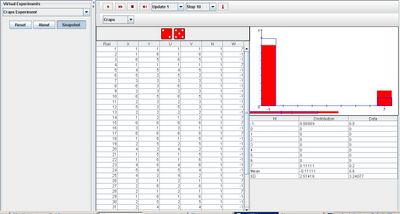SOCR EduMaterials Activities CrapsExperiment
From Socr
Contents |
Craps Experiment
Description of the Game of Craps
General Rules
In the game of craps, the shooter rolls a pair of fair die. The rules are as follows:
- If the shooter rolls a sum of 7 or 11 on the first roll, she wins.
- If the shooter rolls a sum of 2, 3, or 12on the first roll, she loses.
- If the shooter rolls a sum of 4, 5, 6, 8, 9, or 10, this number becomes the shooter's point. The shooter continues to roll the dice until the sum is either the point (in which case she wins) or 7 (in which case she loses).
SOCR Experiment Description
Any of the following bets can be selected from the list box:
- Pass: this is the bet that the shooter will win, and pays 1:1.
- Don't Pass: this is the bet that the shooter will lose, except that an initial roll of 12 is excluded (that is, the shooter loses, but they don't pass bettor neither wins nor loses). The bet pays 1:1.
- Field: this is a bet on a single throw. It pays 1:1 if 3, 4, 9, 10, or 11 is thrown, 2:1 if 2 or 12 is thrown, and loses otherwise.
- Craps: this is a bet that 2, 3, or 12 will come up on a single throw, and pays 7:1.
- Craps 2: this is a bet that 2 will come up on a single throw, and pays 30:1.
- Craps 3: this is a bet that 3 will come up on a single throw, and pays 15:1.
- Craps 12: this is a bet that 12 will come up on a single throw, and pays 30:1.
- Seven: this is a bet that 7 will come up on a single throw, and pays 4:1.
- Eleven: this is a bet that 11 will come up on a single throw, and pays 15:1.
- Big 6. This is a bet that 6 will be thrown before 7, and pays 1:1.
- Big 8: this is a bet that 8 will be thrown before 7, and pays 1:1.
- Hardway 4: this is a bet that (2, 2) will be thrown before 7 or any other 4, and pays 7:1.
- Hardway 6. this is a bet that (3, 3) will be thrown before 7 or any other 6, and pays 9:1.
- Hardway 8: this is a bet that (4, 4) will be thrown before 7 or any other 8, and pays 9:1.
- Hardway 10: this is a bet that (5, 5) will be thrown before 7 or any other 10, and pays 7:1.
Random variables X and Y denote the outcomes of the first roll and random variables U and V denote the outcome of the last roll. On each update, these values are recorded in the data table. W gives the net winnings for the chosen bet and is also recorded in the data table.
The probability density function and moments of W are shown in blue and the empirical density function and moments of W are shown in red in the distribution graph to the right. The distribution table records the values of the probability density and empirical density of W.
Goals of Craps Activity
While providing an accessible simple simulation demonstrating the game of Craps, the user will also obtain knowledge and a general understanding of probability and chance.
Experiments
Go to the SOCR Experiments and select the Craps Experiment from the drop-down list of experiments on the top left. The image below shows the initial view of this experiment:

When pressing the play button, one trial will be executed and recorded in the distribution table below. The fast forward button symbolizes the nth number of trials to be executed each time. The stop button ceases any activity and is helpful when the experimenter chooses “continuous,” indicating an infinite number of events. The fourth button will reset the entire experiment, deleting all previous information and data collected. The “update” scroll indicates nth number of trials (1, 10, 100, or 1000) performed when selecting the fast forward button and the “stop” scroll indicates the maximum number of trials in the experiment.
From the list box, when selecting any type of bet, the probability density function and moments of W will always have an equal or greater value of -1. The image below demonstrates this:

This shows that the player is most likely to lose the bet. As the number of trials increase, the probability density function of W converges to the empirical density function of W. This is shown below:

Notice that within the distribution table, the mean obtains a negative value at all times, also showing that the chances of the player to win is unlikely, despite the values of standard deviation.
Applications
The Craps Experiment is useful to the original casino game of Craps but it may also be used in other activities other than gambling. For example, utilizing this experiment in any event that suggest random sampling but in reality, the likelihood of a success is low compared to failure.
Translate this page:
